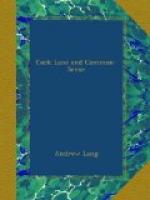Of all common sensible explanations, the most sporting and good-humoured is that given by the step-daughter of Alexander Dingwall, a tenant in Inverinsh, in 1761. Poor Dingwall in his cornyard ’heard very grievous lamentations, which continued, as he imagined, all the way to the seashore’. These he regarded as a warning of his end, but his stepdaughter sensibly suggested that, as the morning was cold, ’the voice must be that of a fox, to cause dogs run after him to give him heat’. Dingwall took to bed and died, but the suggestion that the fox not only likes being hunted, but provokes it as a form of healthy exercise, is invaluable. The tale is in Theophilus Insulanus, on the second sight.
There is no conclusion to be drawn from this mass of Cock Lane stories. Occasionally an impostor is caught, as at Brightling, in 1659. Mr. Joseph Bennet, a minister in that town, wrote an account of the affair, published in Increase Mather’s Remarkable Providences. ‘Several things were thrown by an invisible hand,’ including crabs! ’Yet there was a seeming blur cast, though not on the whole, yet upon some part of it, for their servant girl was at last found throwing some things.’ She averred that an old woman had bidden her do so, saying that ’her master and dame were bewitched, and that they should hear a great fluttering about their house for the space of two days’. This Cock Lane phenomenon, however, is not reported to have occurred. The most credulous will admit that the maid is enough to account for the Brightling manifestations; some of the others are more puzzling and remain in the region of the unexplained.
APPARITIONS, GHOSTS, AND HALLUCINATIONS.
Apparitions appear. Apparitions are not necessarily Ghosts. Superstition, Common-sense, and Science. Hallucinations: their kinds, and causes. Aristotle. Mr. Gurney’s definition. Various sources of Hallucination, external and internal. The Organ of Sense. The Sensory Centre. The Higher Tracts of the Brain. Nature of Evidence. Dr. Hibbert. Claverhouse. Lady Lee. Dr. Donne. Dr. Hibbert’s complaint of want of evidence. His neglect of contemporary cases. Criticism of his tales. The question of coincidental Hallucinations. The Calculus of Probabilities: M. Richet, MM. Binet et Fere; their Conclusions. A step beyond Hibbert. Examples of empty and unexciting Wraiths. Our ignorance of causes of Solitary Hallucinations. The theory of ‘Telepathy’. Savage metaphysics of M. d’Assier. Breakdown of theory of Telepathy, when hallucinatory figure causes changes in physical objects. Animals as Ghost-seers: difficult to explain this by Telepathy. Strange case of a cat. General propriety and lack of superstition in cats. The Beresford Ghost, well-meaning but probably mythical. Mrs. Henry Sidgwick: her severity as regards conscientious Ghosts. Case of Mr. Harry. Case of Miss Morton. A difficult case. Examples in favour of old-fashioned theory of Ghosts. Contradictory cases. Perplexities of the anxious inquirer.




